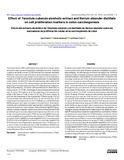| dc.rights.license | http://creativecommons.org/licenses/by-nc-sa/3.0/ve/ | es_VE |
| dc.contributor.author | Ozdemir, Ozagur | |
| dc.contributor.author | Akcakavak, Gokhan | |
| dc.contributor.author | | |
| dc.contributor.author | Tuzcu, Mehmet | |
| dc.date.accessioned | 2023-01-13T16:07:13Z | |
| dc.date.available | 2023-01-13T16:07:13Z | |
| dc.date.issued | 2023 | |
| dc.identifier.issn | 0798-2259 | |
| dc.identifier.uri | http://www.saber.ula.ve/handle/123456789/48831 | |
| dc.description.abstract | Colorectal Cancer (CRC) is defined as colon and rectum cancer and is
among the major causes of mortality in developed Countries. Tarantula
cubensis alcoholic extract (TCAE) and Nerium oleander distillate
(NOD) are reported to have anticancer and antioxidative activity. In
this study, it was aimed to research the impact on cell proliferation
markers of TCAE and NOD given simultaneously in experimental
colon cancer. A total of 24 rats, 6 in each group, were used in the
study. Cancer Control (CC): Azoxymethane was administered at the
beginning of the experiment at a dose of 15 miligrams (mg)· kilograms -1
(kg), (Subcutaneous, SC) twice, with an interval of a week (wk), to
induce cancer. CC+TCAE: the dosage of Azoxymethane administered
was 15 mg·kg -1 (SC) twice a wk at the beginning of the experiment,
while in the case of TCAE, it was 0.2 mL·kg -1 (SC) once a wk for 18
wk from the beginning of the experiment. Fifteen mg·kg -1 (SC) of
Azoxymethane was administered twice at one-wk intervals at the
beginning of the experiment to the CC+NOD group, and NO distillate
(NOD) was given with water throughout the experiment. Afterwards,
animals were euthanized under appropriate conditions, paraffin
blocks formed from colon tissues, histochemical AgNOR (Silver-
stained nucleolar organizer regions), and immunohistochemical PCNA
(proliferating cell nuclear antigen) stainings were performed. In the
study, immunohistochemically, PCNA scores and AgNOR count per
nucleus (AgNCI) were significantly decreased in C-TCAE and C-NOD
groups (P<0.001). AgNOR Area index (AgNAI) (P<0.01), Core Area Index
(CAI) (P<0.05), and AgNOR Area index/Core Area Index (AgNAI/CAI)
(P<0.01) scores were significantly decreased in the C-TCAE group. As
a result, it was concluded that both TCAE and NOD are effective as
chemopreventive drugs and that TCAE presents a more pronounced
antiproliferative effect than NOD. | es_VE |
| dc.language.iso | es | es_VE |
| dc.publisher | SaberULA | es_VE |
| dc.rights | info:eu-repo/semantics/openAccess | es_VE |
| dc.subject | Azoximetano | es_VE |
| dc.subject | AgNOR | es_VE |
| dc.subject | Inmunohistoquímica | es_VE |
| dc.subject | PCNA | es_VE |
| dc.subject | Patología | es_VE |
| dc.title | Effect of Tarantula cubensis alcoholic extract and Nerium oleander distillate on cell proliferation markers in colon carcinogenesis | es_VE |
| dc.title.alternative | Efecto del extracto alcohólico de Tarantula cubensis y el destilado de Nerium oleander sobre los marcadores de proliferación celular en la carcinogénesis de colon | es_VE |
| dc.type | info:eu-repo/semantics/article | es_VE |
| dc.description.abstract1 | El cáncer colorrectal (CCR) se define como el cáncer de colon y recto,
y se encuentra entre las principales causas de mortalidad en los países
desarrollados. Se informa que el extracto alcohólico de Tarántula
cubensis (TCAE) y el destilado de Nerium oleander (NOD) tienen actividad
anticancerígena y antioxidante. En este estudio, el objetivo fue
investigar los efectos de TCAE y NOD administrados simultáneamente
sobre los marcadores de proliferación celular en el cáncer de colon
experimental. En el estudio se utilizaron un total de 24 ratas, 6 en cada
grupo. Control del Cáncer (CC). se administró azoximetano al comienzo
del experimento a una dosis de 15 miligramos (mg)·kilogramos -1 (kg)
(subcutánea, SC) dos veces, con una semana (sem) de diferencia, para
inducir el cáncer. CC+TCAE: la dosis de Azoximetano administrada
fue de 15 mg·kg -1 (SC) dos veces por sem al inicio del experimento,
mientras que en el caso de TCAE fue de 0,2 mL·kg -1 (SC) una vez por
sem durante 18 sem desde el inicio del experimento. Se administraron
15 mg·kg -1 (SC) de azoximetano dos veces a intervalos de una sem al
comienzo del experimento al grupo CC+NOD, y se administró destilado
de NO (NOD) con agua durante todo el experimento. Posteriormente,
los animales fueron sacrificados en condiciones apropiadas, se
realizaron bloques de parafina formados a partir de tejidos de colon,
AgNOR histoquímico (regiones organizadoras nucleolares teñidas
con plata) e inmunohistoquímico PCNA (antígeno nuclear de células
proliferantes) se realizaron. En el estudio, inmunohistoquímicamente,
las puntuaciones de PCNA y el recuento de AgNOR por núcleo (AgNCI) se
redujeron significativamente en los grupos C-TCAE y C-NOD (P<0,001).
Las puntuaciones del índice de área AgNOR (AgNAI) (P<0,01), el índice
de área central (CAI) (P<0,05) y el índice de área AgNOR/índice de área
central (AgNAI/CAI) (P<0,01) se redujeron significativamente en el
C-TCAE grupo. Como resultado se concluyó que, tanto TCAE como NOD
son efectivos como fármacos quimiopreventivos y que TCAE presenta
un efecto antiproliferativo más pronunciado que NOD. | es_VE |
| dc.description.email | Tuzcu, Mehmet | es_VE |
| dc.identifier.depositolegal | pp199102ZU46 | |
| dc.identifier.edepositolegal | ppi201502ZU4665 | |
| dc.identifier.eissn | 2477-944X | |
| dc.publisher.pais | Venezuela | es_VE |
| dc.subject.institucion | Universidad del Zulia (LUZ) | es_VE |
| dc.subject.institucion | Universidad de Los Andes (ULA) | es_VE |
| dc.subject.keywords | Azoxymethane | es_VE |
| dc.subject.keywords | AgNOR | es_VE |
| dc.subject.keywords | Immunohistochemistry | es_VE |
| dc.subject.keywords | PCNA | es_VE |
| dc.subject.keywords | Pathology | es_VE |
| dc.subject.publicacionelectronica | Revista Científica | |
| dc.subject.seccion | Revista Científica: Artículos | es_VE |
| dc.subject.thematiccategory | Medio Ambiente | es_VE |
| dc.subject.tipo | Revistas | es_VE |
| dc.type.media | Texto | es_VE |


